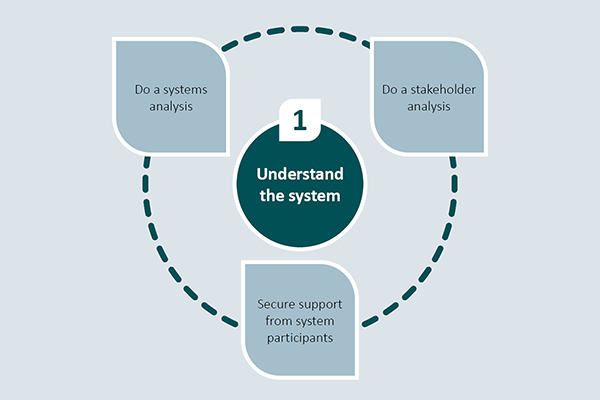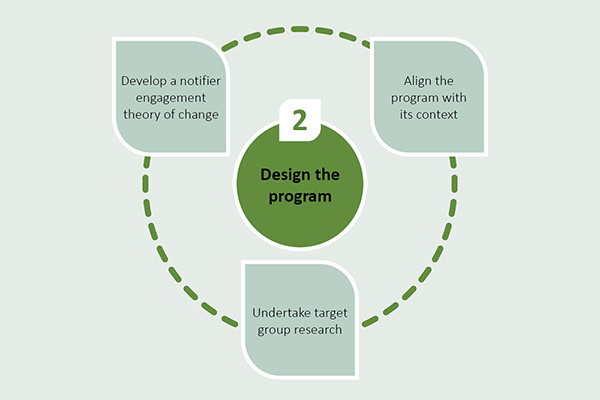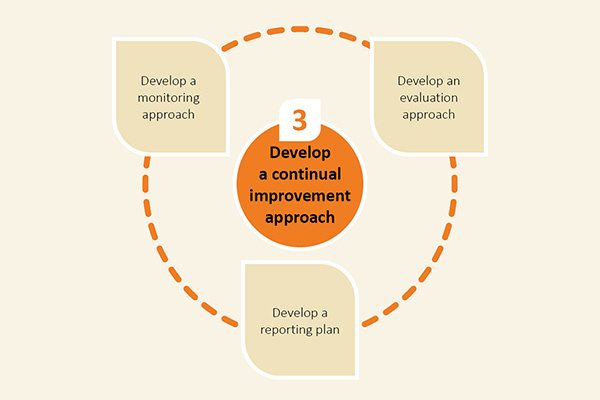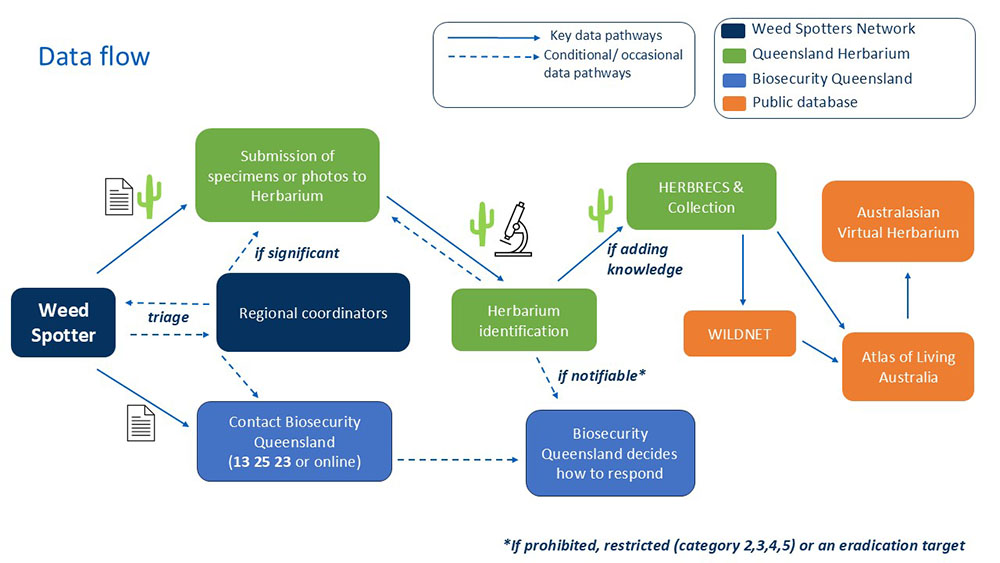ABARES is developing a Manual for General Surveillance Program Design, Monitoring and Evaluation (M&E). This practical, step-by-step resource supports program coordinators and teams in designing general surveillance programs, including a built-in M&E component. It complements the Guidelines for General Surveillance Programs, which outline key design considerations.
M&E is a valuable tool for program teams to:
- track progress toward goals
- build evidence on what works and what doesn’t
- adapt to emerging challenges and opportunities
- demonstrate impact to stakeholders and funders.
Monitoring focuses on tracking activities and outcomes to keep programs on course. Evaluation assesses how effective, efficient, and relevant a program is to help guide improvements and better decision-making.
The manual draws on:
- systems thinking
- the MERI (Measurement, Evaluation, Reporting and Improvement) approach used in community-based natural resource management (e.g. Landcare)
- practical insights from general surveillance programs
- M&E literature on active surveillance and citizen science.
Five diverse programs are currently piloting a draft version of the manual. Their experiences and outputs will help refine the final version which will be publicly available in mid-2026.
For more information about the project, contact the Social Sciences Program at socialsciences.abares@aff.gov.au.
General surveillance programs to test the manual
Currently there are 5 general surveillance programs running across Australia that are testing the manual. Explore each program to learn more about its main purpose and key results.
The aim of the Weed Spotters Network Queensland (WSNQ) is the early detection of new and emerging weed threats before they become established in Queensland. It is a collaboration between the Queensland Herbarium (Department of Environment, Science, Tourism and Innovation) and Biosecurity Queensland (Department of Primary Industries) in partnership with local governments and the community.
The network includes around 1,900 members from government agencies and community groups.
Participants receive a monthly newsletter and have access to online and in-person training and a handbook to help detect, collect and report weeds.
Reports are submitted to Biosecurity Queensland, the Queensland Herbarium or to one of the 20 volunteer regional coordinators.
When a significant weed is detected, Biosecurity Queensland determines the appropriate response.
The program has led to numerous important detections, including recent cases involving high-risk non-native Acacia species.
The aim of the Fall Army Warm (FAW) New South Wales (NSW) program is to build local surveillance capacity and strengthen networks with growers across NSW. It is implemented by the Local Land Services of NSW.
Early FAW monitoring efforts in NSW used bucket traps to track its spread, but surveillance activity later declined.
The Local Land Services secured funding to trial automated surveillance traps. The automated surveillance traps are developed by RapidAIM and use species-specific lures and transmit data remotely.
The traps have been deployed across key dairy regions in NSW, including the North Coast, Hunter, Greater Sydney, and Southeast.
The FAW program provides timely pest presence data to growers of susceptible crops such as maize, sorghum, and ryegrass that helps farmers and contractors make informed pest management decisions.
The data also feeds into broader engagement with smaller industries and may support future predictive modelling in collaboration with climate teams.
Introduced Marine Pests (IMPs) are non-native marine plants or animals that represent a significant biosecurity threat to social, cultural and economic benefits and are a key stressor on our marine environment.
In 2022, the NSW Department of Primary Industries and Regional Development (DPIRD; formerly NSW Department of Primary Industries) implemented a 5year NSW Marine Pest Surveillance Plan to detect potential introduction of marine pests.
As part of the plan, the NSW Marine Pest Surveillance program was developed. The program currently focuses on surveillance at the six major NSW ports based on international shipping arrivals and high vessel volumes (Yamba, Newcastle, Sydney, Botany, Port Kembla, and Eden) and uses a range of innovative monitoring methods and tools, targeting 21 priority pest species for NSW.
Since commencing the program in 2022, the NSW DPIRD Aquatic Biosecurity Programs team with associated laboratory has worked with port stakeholders for the successful deployment, retrieval and analysis of settlement plates (structures put in the water over a set period to allow marine growth to establish).
Port staff also support surveillance, by being the eyes and ears on the ground after being trained to help identify and report suspicious species.
The program is fully funded by NSW DPIRD until 2026, with efforts underway to expand passive surveillance, to increase marine pest awareness, and build stronger partnerships with port stakeholders and authorities.
Through the ABARES General Surveillance Monitoring and Evaluation project NSW DPIRD is piloting the project’s draft Manual in Port Kembla. The pilot is currently in the early stages of engagement, with commencement of partnership building, and an initial deployment of surveillance arrays in late October 2025. NSW DPIRD will continue to build upon this work through ongoing engagement and partnership building across key priority stakeholders.
A “Sightings of Sick and dead Wild Birds” (SOS Wild Birds) online platform is being developed by the Northern Australia Quarantine Strategy (NAQS) to collect data on sightings of sick or dead wild birds in real-time from anywhere in Australia.
It is currently being designed and tested as part of a pilot project with a view to enhancing general surveillance of wild birds in Australia, with particular emphasis on supporting preparedness and response for H5 bird flu.
The platform has been built using the Survey123 Form Builder and captures details including date of sick or dead wild bird sighting, location, species or taxonomic group, number affected, visible symptoms and photos.
The pilot project commenced in December 2024, and a trial phase is currently underway in participating jurisdictions.
The goal is to develop and test the platform as a standardised tool for logging data on sightings of sick and dead wild birds, and explore its integration into biosecurity reporting, wildlife health and conservation frameworks.
The pilot project is coordinated by Wildlife Health Australia (WHA), with funding from the Australian Government and overseen by a multi-agency advisory team, with representatives from WHA, NAQS, Department of Agriculture, Fisheries and Forestry, and Department of Climate Change, Energy, the Environment and Water.
How SOS Wild Birds may progress from pilot to national program is being considered in consultation with stakeholders.
The Northern Australia Biosecurity Surveillance network (NABSnet) is a program funded by the Northern Australian Biosecurity Strategy (NABS). It represents a collaboration effort between agriculture departments from northern jurisdictions of Western Australia, Northern Territory and Queensland, and the Commonwealth.
NABSnet is an enhanced passive general surveillance program aimed to increase the number and quality of significant disease investigations (SDIs) conducted by private veterinarians across Northern Australia.
The program is supported by independent industry veterinary advisers and provides members with access to a regularly distributed newsletter and a user-friendly website containing reference materials.
NABSnet aims to close the loop on significant disease investigations by providing private veterinarians with subsidised disease investigation support and resources. Value is added by reporting back diagnostic findings and management recommendations to the producer.
While endemic diseases are the common driver of most investigations, emergency animal diseases (EAD) remain a priority, with exclusion testing conducted and reported where applicable. An annual Masterclass provides further practical training to network members. Government veterinary pathologists and veterinary officers also support the program by offering mentorship and technical guidance during investigations.
Since its inception in 2017, the number of SDIs has increased steadily, with 35–40 conducted annually. The program has also supported targeted surveillance efforts, such as skin lesion sampling during trade-related concerns in 2023 related to Lumpy Skin Disease (LSD). Skin lesion sampling continues to be subsidised through NABSnet, contributing to Australia’s LSD surveillance strategy.
The NABSnet continues to evolve in response to industry needs and remains focused on improving animal health surveillance outcomes in Northern Australia.
What to expect in the manual
The draft manual follows a step-by-step framework.



Below outlines what each step involves, why it matters, and examples from the participating general surveillance programs.
1
Find out about the different people and processes involved in making the general surveillance program work.
Do a systems analysis
Understand who is (or should be) involved in maintaining different aspects of the general surveillance program. This includes how they interact, the tools and processes they use, and the rules that apply to them.
Developing a data flow diagram can be helpful to examine how the flow of data from collection to use can be improved. It can also help different stakeholders to understand where their contributions fit.

Do a stakeholder analysis
Analyse the groups and individuals who can affect or are affected by the program.
Download
To ensure effective communication among various stakeholders, developing a knowledge flow or communication diagram is helpful.
Secure support from system participants
Engage with the system participants responsible for different functions.
2
Develop a program logic
Develop a theory of change for notifiers
Design an engagement strategy to attract notifiers and keep them involved.
To provide a clear roadmap and logical flow of how change will occur, developing a program logic is helpful.
Align the program with its context
Work with the data value chain representatives and others to ensure the program is fit-for-context.
Undertake target group research
Gain in-depth understanding of key target groups’ motivations and barriers.
3
Develop a monitoring approach
Decide what to measure, when, how, and for whom and set targets.
Develop an evaluation approach
Decide on the evaluation’s scope, indicators, and data collection and analysis strategy.
Develop a M&E reporting plan
Outline the target audience and their needs, key messages, and appropriate formats and channels for reporting M&E.
